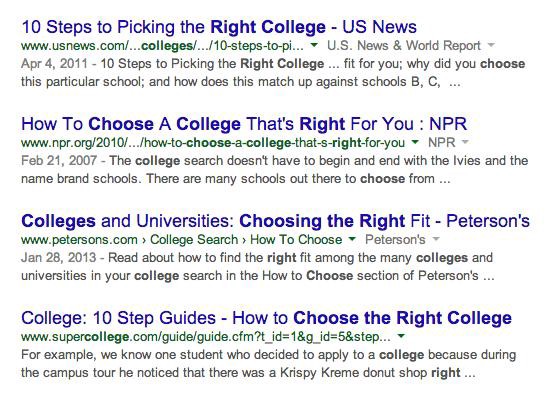“Choosing THE RIGHT School”: BS or Total BS?
We’ve been talking a lot about college on the Billfold lately, which brings up an important question: How do you know if you chose the right school? People in our society make a fetish about picking the place that’s right for you as though there’s only one correct answer, and as though “the place that will give you the most aid” or “the state school closest to home” isn’t the guiding principle behind the way a lot of us make this choice.

Universities seem to serve as kind of a “You complete me” soul-mate stand-in. And for maybe the same reason we talk about “the one” in a romantic context, we take for granted that “the right” college exists out there for everyone interested in higher education. Doesn’t that raise expectations to an unreasonable level? After all, how do you evaluate the choice once you’ve made it?
College is fun but it also requires effort, much like a relationship. We know how to assess relationships*, generally, though! We have seen them modeled in pop culture — Coach & Tami Taylor 4 Eva! — as well as in our own lives. Who teaches us how to evaluate an immersive academic and life experience, especially one that will put us in the red, potentially, for decades? How do we know how happy we’re supposed to feel? How long do you give yourself before you realize maybe you haven’t made the right choice?
In the US, nearly half of all college students drop out without completing their degree. About 1 in 3 students transfer schools at some point in their four or five years of undergrad. More probably begin the process without completing or going through with it. According to the Chronicle of Higher Ed:
The “traditional” path of entering and graduating from the same institution is decreasingly followed, the report says. Students transfer across state lines and institution types, and even “reverse transfer” from four-year to two-year colleges. … Transfer rates are similar for full- and part-time students, 32.6 and 33.9 percent, respectively, the study found. More than a quarter of all transfers cross state lines, and students’ preferred destination is public two-year institutions (except when those are the origin). The most common time for transfer, the report says, is in a student’s second year. …
Still, a surprising number of students make their first transfer during their fourth year of study (13 percent) or fifth year (9 percent). Among students who begin at two-year institutions, 17 percent transfer for the first time in the fourth year, and 11 percent in the fifth.
There is less data on students who transfer more than once, but that’s a reality, too. Not everyone who transfers is satisfied — or even, necessarily, more satisfied — with where they ended up. Have we created unreasonable expectations for what we are to get out of college? Or, considering the price tag, are we justified in having very high standards for what we will receive?
I’m a monogamist by nature, so it fits that I chose one school, applied early, was accepted, went through four years, and graduated without transferring. That makes me feel like it’s hard to imagine having gone to — or being as satisfied — somewhere else. Yet to some degree that’s me drinking the Kool-Aid and I probably would have been, at least at some similar place; I can’t answer for how lost I would have felt at, say, a drastically larger place that wouldn’t have let me be the film critic for four years.
Do you feel like you could have been just as happy going to do a different school, or was your alma mater “the one”? And how did you or do you know?
* Speaking of assessing relationships, I very much hope you’ve given yourself three minutes to watch the 50 Shades of Grey trailer (NSFWish? No nudity, just some gasping and innuendo). It is so worth it. They don’t show Christian Grey’s face for the first suspenseful section, like he’s the shark from Jaws. Which, come to think of it, he totally is.
Support The Billfold
The Billfold continues to exist thanks to support from our readers. Help us continue to do our work by making a monthly pledge on Patreon or a one-time-only contribution through PayPal.
Comments